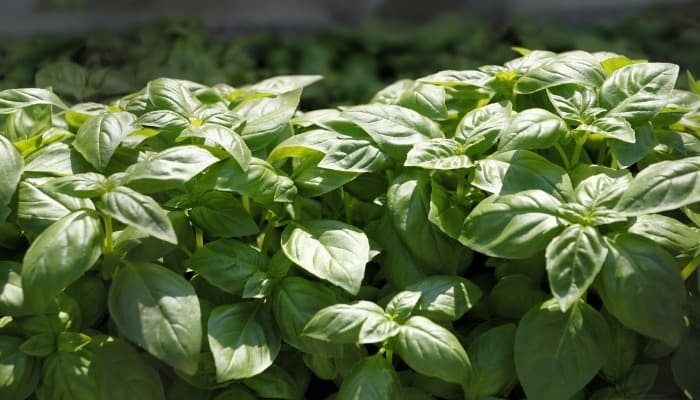Basil, being a fragile herb, requires the assistance of other plants to protect it from insects that eat its leaves. These plants should also work towards preserving or improving its growing conditions.
Plants to avoid at all costs are mint, fennel, and cucumber as these are nutrient guzzlers hell-bent on altering the taste!
The good news is that there are amazing basil companion plants to choose. Let’s take a look at the top 25 and find out why and how they benefit basil.
1. Tomatoes
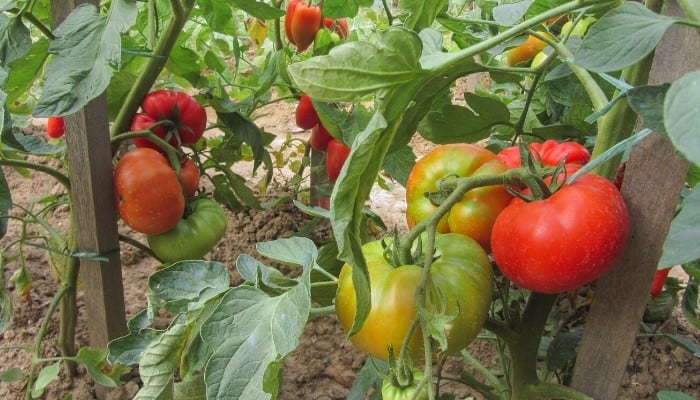
Tomato plants grow between 2 and 6 feet+ tall depending on whether they are upright or trailing varieties.
The medium-green leaves are hairy and multi-lobed and the spherical, smooth fruit is smooth and can be red, pink, yellow, or even purple. The fruits grow from clusters of small yellow flowers.
- Benefits provided: Both crops require 6-8 hours sunlight to thrive and enjoy well-drained soil. Tomatoes also enhance the flavor of basil and vice versa.
- Time until harvest: 60-100+ days
- Popular varieties: ‘Early Girl’, Jersey tomato, ‘Juliet’, ‘San Marzano’
2. Bell Peppers

Bell peppers have a bushy, compact habit with most varieties growing no larger than 3 feet high. Bell peppers feature robust woody stems and lush-green elliptical leaves.
The sweet, thick-skinned bell-shaped fruit ranges from yellow to orange, red to purple, green, and even white.
- Benefits provided: Leaf clusters provide a weather canopy, and as they’re fairly low to the ground, bell peppers suppress weeds and retain soil moisture.
- Time until harvest: 60-80 days
- Popular varieties: ‘Bayonet’, ‘Antebellum’, ‘Galileo’
3. Borage
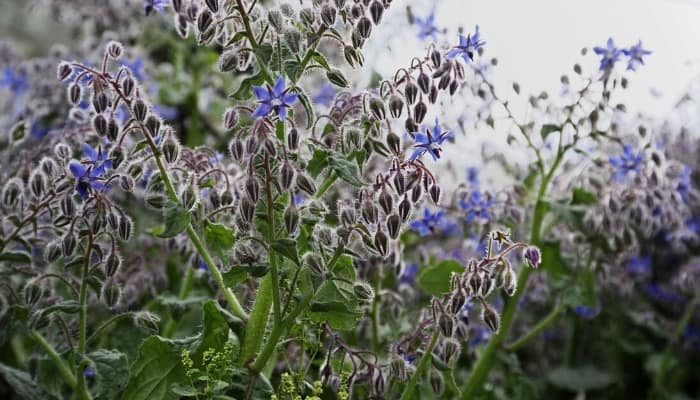
This attractive, fast-growing herb reaches 2 feet tall in an upright habit, producing vivid blue/pink star-shaped flowers that hang down in pendulous clusters from red stalks.
The dark-green oval leaves have a hairy, wrinkled texture and a cucumber-like scent and taste, as do the borage flowers.
- Benefits provided: The flowers attract pollinators including the honeybee and ladybug. The general aroma is also thought to repel leaf-boring pests.
- Time until harvest: 56 days
- Popular varieties: Common borage, ‘Starflower’, ‘Alba’, creeping borage
4. Marigolds
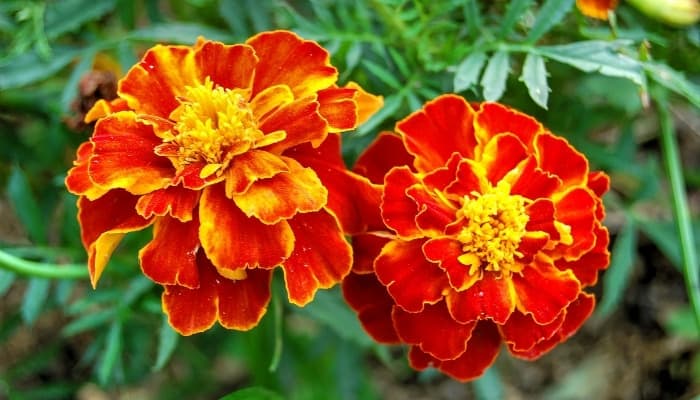
Vibrant marigold plants grow in a bushy, mounding form or produce tall, erect stems varying in height from 0.9-3 feet.
The leaves are dark green with serrated edges and provide stark contrast to the large rounded blooms of white, gold, burnt orange, or mahogany.
- Benefits provided: The strong scent overpowers many insects, and French marigold varieties even release a chemical from their roots known as limonene that sends pest-repelling signals to nearby plants long after the marigolds go!
- Time until harvest: 45-50 days
- Popular varieties: ‘Hero Orange’, ‘Bonanza’, ‘Bounty
5. Garlic
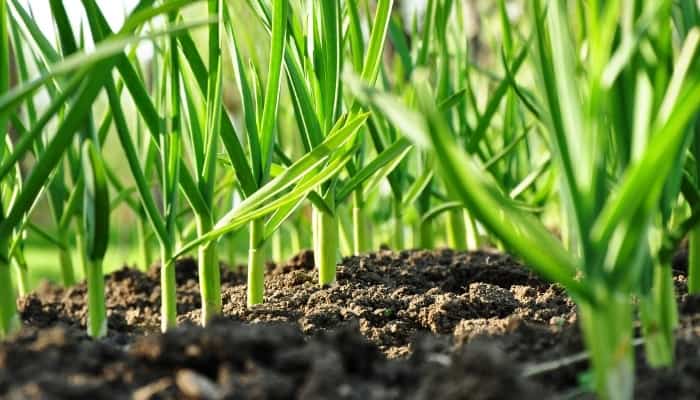
Garlic plants grow between 0.5 and 2 feet tall, producing medium-green grass-like leaves from a slender stalk that grows directly from the edible flower bulb underground.
The pumpkin-shaped white bulb has a faint pinkish-purple tinge and contains multiple cloves within, each protected by a papery casing.
- Benefits provided: Garlic helps enhance the flavor of basil while its powerful aroma repels common basil pests such as aphids, whiteflies, and spider mites.
- Time until harvest: 90 days
- Popular varieties: ‘Christo’, ‘Chesnok Red’, ‘Early Purple Wight’
6. Chili Peppers

Chili peppers grow in shrub-like or upright branching forms with dulled green stems and smooth oval leaves. They reach 1.6-4.9 feet tall.
White five-petal flowers are produced followed by smooth and squat or long, tapered fruit in black, brown, green, yellow, orange, and fiery red shades.
- Benefits provided: Shrub varieties keep weeds at bay and preserve much-needed soil moisture.
- Time until harvest: 60-150 days
- Popular varieties: ‘Devil’s Tongue Pepper’, ‘Tiger Paw’, ‘Carolina Cayenne’
7. Asparagus
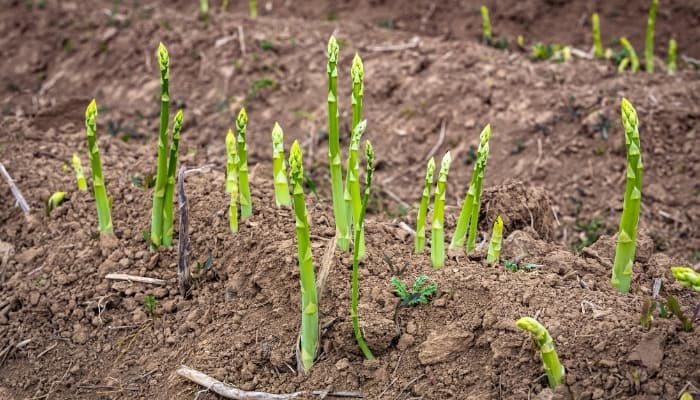
Asparagus plants are formed of thick and fleshy dark-green spears with faint purple tips which grow tall from an underground stem.
This compact crop grows between 3.2 and 5 feet high and features feathery fern-like foliage and greenish-white to yellow bell-shaped flowers.
- Benefits provided: The tall stalks and dense canopy provide shade. Asparagus also attracts ladybugs that prey on aphids.
- Time until harvest: Asparagus takes 2-3 years to fully mature.
- Popular varieties: ‘Jersey Giant’, ‘Apollo’, ‘Atlas’, ‘Mary Washington’
8. Oregano

Oregano plants either grow in creeping or upright habits measuring 1-3 feet in length and height.
The fuzzy, dark-green leaves can be ovular or more arrow-shaped and grow in loose rosette-like clumps. Tiny white/purple/pink flowers also bloom from the tip of the stems.
- Benefits provided: The low, spreading habit keeps basil cool in harsh temperatures while its flowers attract bees and other pollinators.
- Time until harvest: 45 days
- Popular varieties: Italian oregano, Greek oregano, golden oregano
9. Nasturtiums

This beautiful flowering plant grows up to 1 foot as a mounding shrub or up to 3 feet for trailing varieties.
Nasturtiums feature rounded deep-green leaves with cream-colored veins resembling mini lily pads and produce five-petal flowers in rich shades of yellow, red, orange, and paler pastel tones.
- Benefits provided: The bright, welcoming colors make an ideal trap crop as it attracts aphids and other leaf-boring pests.
- Time until harvest: 30-55 days
- Popular varieties: ‘Apricot’, ‘Black Velvet’, ‘Peach Melba’
10. Carrots

Carrots produce a clump of bright-green feathery leaves growing from the top of the tapered root underground.
The foliage measures almost 5 feet tall at maturity while the fleshy taproot grows between 2-20 inches long and varies from orange and yellow to pink, purple, and white.
- Benefits provided: The deep taproot loosens the soil, assisting basil plant roots and drainage. The dense foliage also generates welcome shade.
- Time until harvest: 84-112 days
- Popular varieties: ‘Tendersweet’, ‘Purple Dragon’, ‘Kaleidoscope’
11. Chives
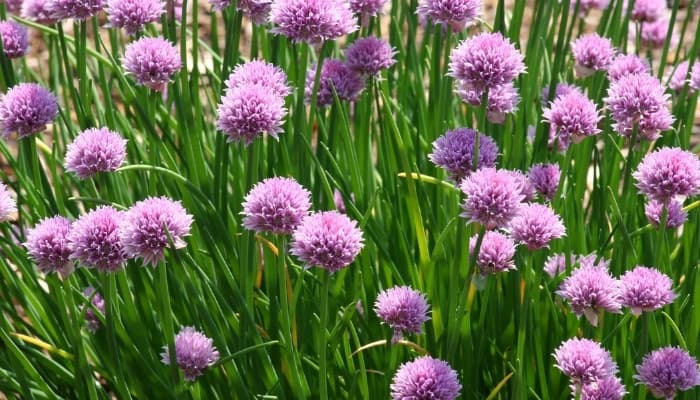
A member of the onion family, chives form a low mound of dark-green strappy leaves resembling grass with globular blooms of purple, lilac, or pink growing from upright stalks.
The leaves grow from elongated white bulbs below ground, and plants typically measure 1-1.6 feet tall.
- Benefits provided: Chives enhance basil flavor by strengthening the essential oils, which in turn helps basil ward off pests.
- Time until harvest: 30-60 days
- Popular varieties: Giant Siberian chives, garlic chives
12. Potatoes
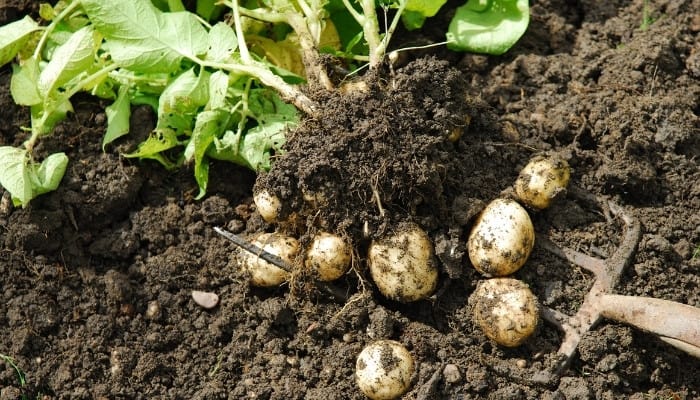
Potatoes form from a swollen underground stem or “tuber,” and from this main stem, extended structures known as stolons develop and enlarge to form up to 20+ tubers/potatoes.
A spiral of medium-green compound leaves emerge above ground measuring over 3 feet high.
- Benefits provided: Potatoes lure in pollinators such as bees and butterflies, and both crops love full sunlight and regular water.
- Time until harvest: 105-140 days
- Popular varieties: ‘Red Pontiac’, ‘Daisy Gold’, ‘Masquerade’
13. Beets

Beets consist of a bulbous or elongated taproot growing below ground that is typically dark red but can also be golden yellow, white, or purple.
A cluster of long red stems grow upright from the taproot producing large medium-green oval leaves with prominent red veins. Beets plants grow 3.3-6.6 feet tall.
- Benefits provided: Beets make an effective trap crop, enticing several herb-eating pests away from your real herb patch.
- Time until harvest: 45-65 days
- Popular varieties: ‘Avalanche’, ‘Early Wonder’, ‘Cylindra’
14. Petunias
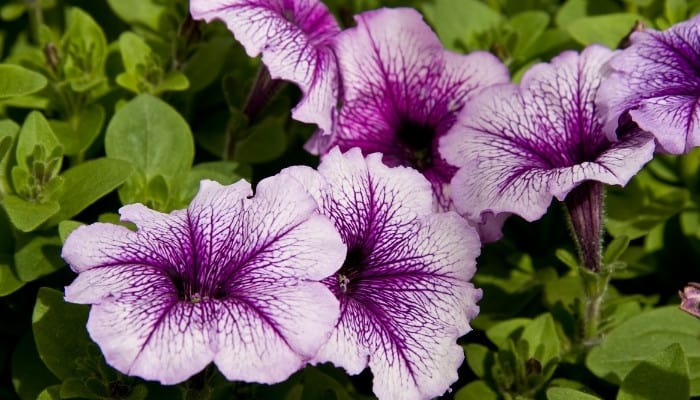
Pretty petunias produce showy funnel-shaped flowers of five petals ranging from pink, red, and purple to blue, yellow, and white.
The deep-green foliage is smooth and ovular, and these plants vary from compact, erect types to long-stemmed spilling varieties – measuring one half foot tall or 1.5 feet long.
- Benefits provided: The flowers attract pollinating bees while repelling leaf-chomping nuisances like leafhoppers and aphids.
- Time until harvest: 70-84 days
- Popular varieties: ‘Phantom’, ‘Priscilla’, ‘Black Satin’
15. Turnips
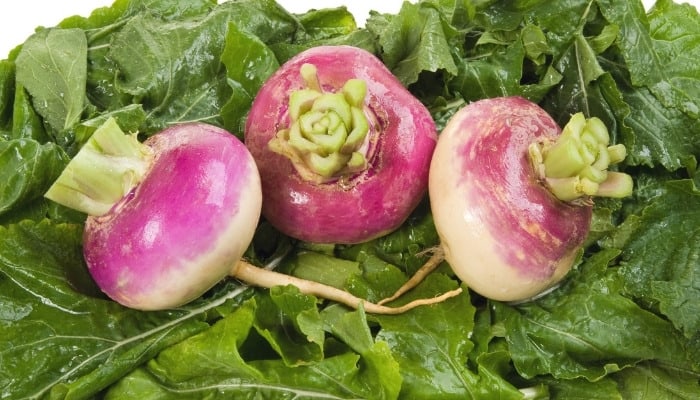
Turnip plants consist of a bulbous, rounded taproot below ground that is typically either cream, yellow, or purple.
A cluster of light green grass-like stems grow out from the taproot and form a rosette of large broad leaves with a hairy texture. Turnips grow 1-1.5 feet tall above ground.
- Benefits provided: Turnips make a stellar trap crop for your basil, and both crops share similar watering requirements.
- Time until harvest: 40-55 days
- Popular varieties: ‘White Lady’, ‘Scarlet Queen’, ‘White Egg’
16. Banana Peppers

A milder cousin of the chili pepper, banana pepper plants produce slender, elongated fruit with smooth, waxy skin and slightly curved end.
They’re commonly yellow but also come in green, orange, and red varieties. This plant features dark-green arrow-shaped leaves and reaches up to 2 feet tall.
- Benefits provided: Maintenance is made easier since both crops appreciate similar climates, soil types, pH, water and sunlight levels! The foliage also provides welcome shade.
- Time until harvest: 60-75 days
- Popular varieties: ‘Hungarian Yellow Wax’, ‘Early Sweet Banana’
17. Cilantro
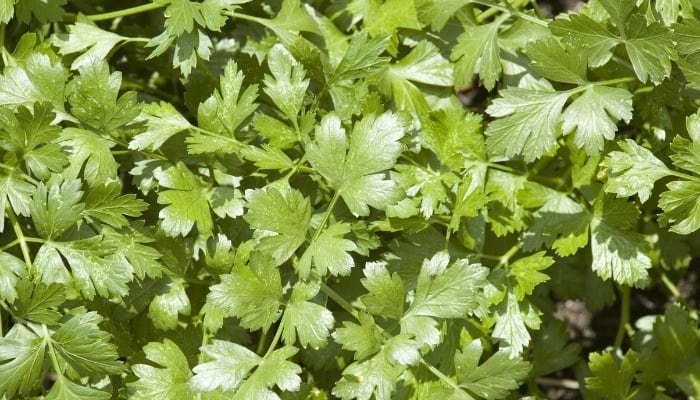
Cilantro or coriander plants produce fine light-green stems that branch off into small needle-like leaves and broader, waxy foliage with fringed edges.
Cilantro stems are topped with clusters of dainty pink/white flowers that produce perfectly spherical tan-colored seeds (coriander). Plants measure 1-2 feet tall.
- Benefits provided: This plant’s stimulating oils repel many a nemesis of basil, including aphids, beetles, and whiteflies.
- Time until harvest: 45-70 days
- Popular varieties: ‘Confetti’, ‘Dwarf lemon’, ‘Moroccan’
18. Radishes
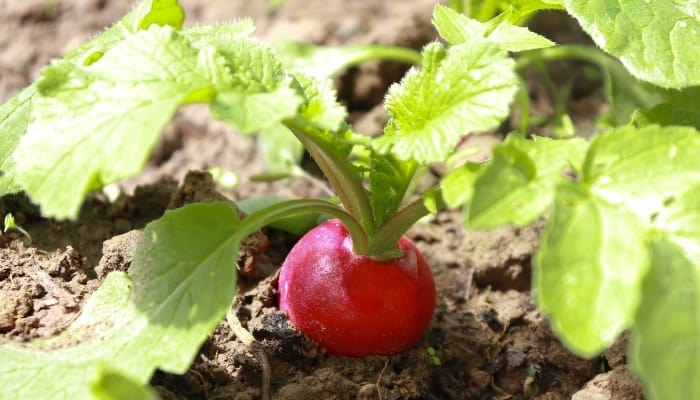
Radish plants produce orbital or longer tapered taproots below ground, commonly in red or white but also black to purple and yellow depending on the variety.
A ground-level rosette of broad medium-green leaves forms from the taproot, reaching up to 3 feet tall overall.
- Benefits provided: As radishes are such speedy growers, they can serve as markers for slower-growing basil.
- Time until harvest: 20-25 days
- Popular varieties: ‘Scarlet Globe’, ‘Tarzan’, ‘French Breakfast’
19. Parsley
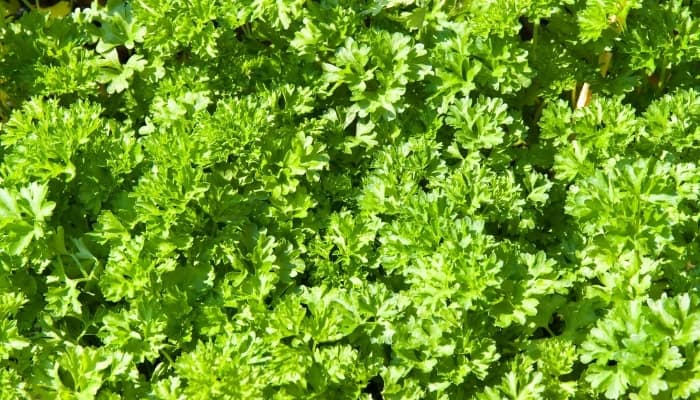
This aromatic herb has an erect growth habit, reaching between 1 and 3 feet. Parsley features slender hollow stems with clumps of dark-green leaves either flat or with frilly/curled edges.
It also produces short stalks of tiny yellow flower clusters.
- Benefits provided: Parsley repels nematodes and beetles, and both crops thrive in consistent moisture and full sunlight.
- Time until harvest: 70-90 days
- Popular varieties: Italian flat-leaf parsley, common curly parsley
20. Parsnips
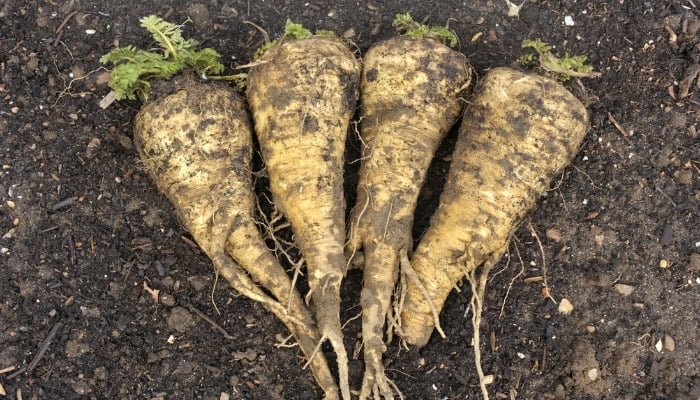
Parsnip consists of cream-colored taproots with a slender, tapered shape.
Erect, branched stems are sent up above ground, producing a rosette of bright-green leaves that can be triangular or oblong in shape.
Taproots grow 4-9 inches long while the overall plant reaches 3-6 feet tall.
- Benefits provided: When its flowers go to seed, parsley will attract predatory insects that prey on basil-munching pests. Also, parsnip roots release a substance that’s toxic to spider mites and aphids.
- Time until harvest: 105-13 days
- Popular varieties: ‘Albion’, ‘All-American’, ‘Javelin’
21. Marjoram
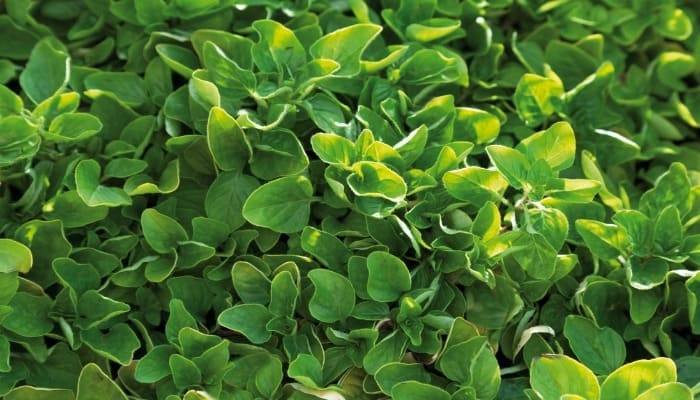
Often confused with oregano, marjoram, or sweet marjoram, is a bushy plant reaching 1-2 feet tall and is dense with fuzzy oval leaves of lush green.
Marjoram plants also have a warm aroma and produce pale non-showy flowers.
- Benefits provided: Marjoram grows in sync with basil’s water/sunlight needs. It also attracts pollinators and predatory insects to cut down on common pests.
- Time until harvest: 60-90 days
- Popular varieties: Sweet marjoram, wild marjoram French or “pot” marjoram
22. Chamomile

Sweet and fresh chamomile plants produce several daisy-like flowers with white petals and sunny yellow centers that either grow tall on branched stems up to 3 feet or upon creeping mat-like growth measuring 6 inches high.
- Benefits provided: Chamomile plants release beneficial chemicals in the soil that are thought to promote better growth and improve basil flavor.
- Time until harvest: 42-56 days
- Popular varieties: ‘Moroccan’, ‘Roman’, ‘Stinking Chamomile’
Final Thoughts
To sum up, there are a wealth of beneficial plants to pair up with your basil plant from those that help to enhance the flavor to ones with near-identical needs and “trap crops” to deter leaf-munching critters away from your developing basil leaves!

